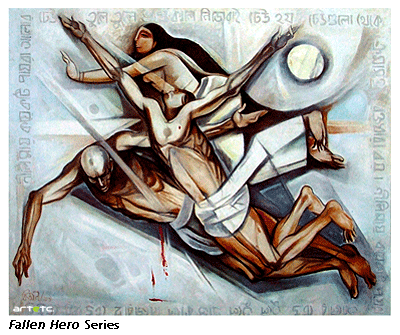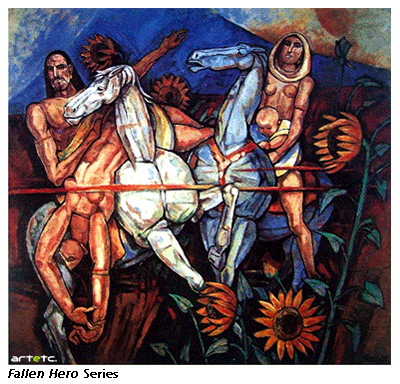- Editorial
- Shibu Natesan Speaks on Protest Art
- Rising Against Rambo: Political Posters Against US Aggression
- Transient Imageries and Protests (?)
- The Inner Voice
- Bhopal – A Third World Narrative of Pain and Protest
- Buddha to Brecht: The Unceasing Idiom of Protest
- In-between Protest and Art
- Humour at a Price: Cartoons of Politics and the Politics of Cartoons
- Fernando Botero's Grievous Depictions of Adversity at the Abu Ghraib
- Up Against the Wall
- Rage Against the Machine: Moments of Resistance in Contemporary Art
- Raoul Hausmann: The Dadaist Who Redefined the Idea of Protests
- When Saying is Protesting -
- Graffiti Art: The Emergence of Daku on Indian Streets
- State Britain: Mark Wallinger
- Bijon Chowdhury: Painting as Social Protest and Initiating an Identity
- A Black Friday and the Spirit of Sharmila: Protest Art of North East India
- Ratan Parimoo: Paintings from the 1950s
- Mahendra Pandya's Show 'Kshudhit Pashan'
- Stunning Detours of Foam and Latex Lynda Benglis at Thomas Dane Gallery, London
- An Inspired Melange
- Soaked in Tranquility
- National Museum of Art, Osaka A Subterranean Design
- Cartier: "Les Must de Cartier"
- Delfina Entrecanales – 25 Years to Build a Legend
- Engaging Caricatures and Satires at the Metropolitan Museum
- The Mesmerizing World of Japanese Storytelling
- The Metropolitan Museum of Art Exhibiting Lyrical Visions: Paintings from North India
- Random Strokes
- Asia Week at New York
- Virtue of the Virtual
- What Happened and What's Forthcoming
- Art Events Kolkata, March – April 2012
- Mumbai Art Sighting
- Art Bengaluru
- Delhi Dias
- Preview, April, 2012 – May, 2012
- In the News, April 2012
- Cover
ART news & views
Bijon Chowdhury: Painting as Social Protest and Initiating an Identity
Issue No: 28 Month: 5 Year: 2012
by Mrinal Ghosh

 An essential element in the paintings of Bijon Chowdhury (1931-2012) is his political consciousness generated out of his very sincerely cultivated commitment towards socio-temporal reality and protest against exploitation of human being by the centers of political and economic power causing devastating decay in human values and existential conditions. He had deep faith in Marxist ideology but he never allowed his art to turn towards political propaganda. Search for an indigenous identity through confluence of tradition and modernity was an important feature of his works. In the paintings where he highlighted political and social protest he used to turn his robust and powerful imageries into iconic symbols generating rebellion and aspiration to come out of the decadence and defeat of humanity. His series on Return of the Hero of 1968 and Fallen Hero of 1979 exemplifies this trend, where the fight of humanity against the opposing forces is highlighted through cubist and expressionist dramatic formal structures.
An essential element in the paintings of Bijon Chowdhury (1931-2012) is his political consciousness generated out of his very sincerely cultivated commitment towards socio-temporal reality and protest against exploitation of human being by the centers of political and economic power causing devastating decay in human values and existential conditions. He had deep faith in Marxist ideology but he never allowed his art to turn towards political propaganda. Search for an indigenous identity through confluence of tradition and modernity was an important feature of his works. In the paintings where he highlighted political and social protest he used to turn his robust and powerful imageries into iconic symbols generating rebellion and aspiration to come out of the decadence and defeat of humanity. His series on Return of the Hero of 1968 and Fallen Hero of 1979 exemplifies this trend, where the fight of humanity against the opposing forces is highlighted through cubist and expressionist dramatic formal structures.
Horse was an essential subject of these series of paintings. His horse was the symbol of dynamism and power. The hero, his protagonist character, fights against the opposing forces riding and moving on the horse back. Sometimes he returns victorious, sometimes defeated. The defeat and humiliation that our nation suffered, the dominant force of youth had to confront, due to colonial oppression, due to national and international commotion, wars, communal strife, violence and belligerence of the of the agencies of power before and after the freedom of our country have cumulatively instigated him towards the rebellion expressed in these series of works.
 But his rebellion was not limited within this negative compassion only. His political personality, his love for the tradition and culture of his country inspired him towards search for an indigenous identity in his paintings. He felt the classical sculpture, classical and traditional music and folk painting of our country contain the wisdom on which our civilization has been built up through out the ages. He explored these sources to build up the form of his painting. His forms turned sculpturesque. Within the voluminousness of the figures he expressed the exuberance of an inner force coming out towards the surface expressing a positive spiritual sensibility that our sculpture contains, which also has been a source of beauty in our Kalighat paintings. Music came to be an important theme for his paintings. He also used classical, folk and mythical episodes as subject of his painting. Search for an identity exploring all these elements became an essential feature of his expression.
But his rebellion was not limited within this negative compassion only. His political personality, his love for the tradition and culture of his country inspired him towards search for an indigenous identity in his paintings. He felt the classical sculpture, classical and traditional music and folk painting of our country contain the wisdom on which our civilization has been built up through out the ages. He explored these sources to build up the form of his painting. His forms turned sculpturesque. Within the voluminousness of the figures he expressed the exuberance of an inner force coming out towards the surface expressing a positive spiritual sensibility that our sculpture contains, which also has been a source of beauty in our Kalighat paintings. Music came to be an important theme for his paintings. He also used classical, folk and mythical episodes as subject of his painting. Search for an identity exploring all these elements became an essential feature of his expression.
Actually he started his artistic career through the search for the tradition. As early as 1962 in his solo exhibition held at Art and Prints Gallery of Kolkata he explored the forms of Kalighat paintings. In a review the news paper Statesman wrote, “He has drawn on traditional Pat and terracotta techniques.” The paper also commented, “It cannot be denied his works are fundamentally Indian in exuberance and spirit.” Meditating within this traditional spirit he extended his search towards Western modernist forms like cubism and expressionism and through the confluence built up his own idioms of rebellion and identity that has made him an important exponent of Indian art activities of 1960-s.